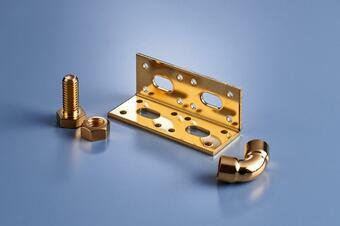When we think of gold plating, the decorations and adornments found in temples and shrines may come to mind first. But gold plating is also an integral aspect of various electronic products.
More than just a glittering decorative metal, gold boasts good corrosion resistance, oxidation resistance, electrical and thermal conductors, low contact resistance, and good solderability and bondability.
Thus no plating metal is used in a wider range of applications than gold. As a limited resource in high demand, gold is more expensive than other plating metals.

Basic characteristics
| Wear resistance | Heat resistance | Corrosion resistance | Chemical resistance | Decorativeness | Lubricity | Adhesion | Electrical conductivity | Dimensional accuracy |
| △~〇 | 〇 | ◎ | ◎ | ◎ | 〇 | ◎ | ◎ | 〇 |
Features
Features 1Excellent corrosion resistance
Gold is a very stable metal whose properties do not change.
Gold is one of the few metals that is generally unaffected by acids and alkalis. Since gold is extremely resistant to oxidation and its properties do not change, gold plating is found in products that require both decorative qualities and varied functionality.
Good solderability
Nickel and copper develop an oxide film on their surfaces, resulting in a reduction of strength and reliability when they are soldered to other metals.
Applying a thin layer of gold plating (Au) over nickel plating inhibits the oxidation of the nickel surface. Furthermore, since gold is highly resistant to oxidization and corrosion, it can maintain good solderability for a long period of time.
* Tin plating can maintain good solderability for a short period of time. However, there is a risk of short circuit due to whiskers.
High electrical conductivity
Gold is the third most electrically conductive metal after silver and copper.
The electrical conductivity of silver and copper deteriorates due to corrosive processes such as oxidation and sulfurization. As gold is not susceptible to such changes in its properties, long-term performance maintenance can be expected. Thus gold is often used for plating contact points.
Plating equipment
| Bath type | Processing type | Maximum size | Maximum weight | |
|---|---|---|---|---|
| (1) | Hard gold (gold cobalt alloy plating) | Manual rack | 300×150×400H | 10kg |
| (2) | Hard gold (gold cobalt alloy plating) | Automatic rack | 700×200×600H | 20kg |
| (3) | Soft gold (pure gold plating) | Manual rack | 400×100×200H | 5Kg |
Proceccable materials
Copper, copper alloy, stainless steel, aluminum, etc.
Aluminum alloys, aluminum die castings, aluminum castings, etc.
Copper, copper alloy, stainless steel, aluminum, etc.
Application
Decoration of solder joint parts, electrical contact parts, electronic substrates, semiconductors, wafer bonding parts, accessories, musical instruments, etc.